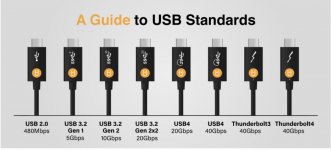mikenott
Flawed but improving!

This isn’t rocket science and if you know all about USB C cables – just ignore this post. I’ve aimed at people like myself who are not experts but may need some help.
I have read a lot on here about slow transfer speeds and I got frustrated with slow/inconsistent read speeds from my R5 CF Express card using a ProGrade CF Express B/SD reader and various USB C cables. My PC is pretty high spec and it's a fast card so why was I getting transfer speeds of 40 MB/s in Windows 11?
Realised it could be the USB C cables which I have accumulated over the years both USB A to USB C and USB C to USB C. But surely all USB C connections are inherently fast? Apparently not! Found the graphic below which shows the different types. So off I went to look at the end of my USB cables for the relevant icon - but 12 of 15 were just blank or showed the (basic) USB 2.0 icon so that didn’t help.
Did my own tests by transferring a 1GB file from my PC to the card reader (and vice versa). All but one of my 15 USB C cables ran at 40 MB/s maximum even though they had the blue USB A connector and a USB C connector. But one random lead (with the basic USB icon ) rocketed away at 360 MB/s!! Subsequently bought two USB 3.2 Gen 2x2 cables (with a clear and obvious SS 20 USB logo and that takes some finding!) and they also rocked away at 460 Mb/s. Transfer speed issue solved!
) rocketed away at 360 MB/s!! Subsequently bought two USB 3.2 Gen 2x2 cables (with a clear and obvious SS 20 USB logo and that takes some finding!) and they also rocked away at 460 Mb/s. Transfer speed issue solved!
As an aside, I recently bought a high duty USB C PD cable to run my R5 off a battery pack. Transferred at 40 MB/s
So, my key learnings are:
Michael

I have read a lot on here about slow transfer speeds and I got frustrated with slow/inconsistent read speeds from my R5 CF Express card using a ProGrade CF Express B/SD reader and various USB C cables. My PC is pretty high spec and it's a fast card so why was I getting transfer speeds of 40 MB/s in Windows 11?
Realised it could be the USB C cables which I have accumulated over the years both USB A to USB C and USB C to USB C. But surely all USB C connections are inherently fast? Apparently not! Found the graphic below which shows the different types. So off I went to look at the end of my USB cables for the relevant icon - but 12 of 15 were just blank or showed the (basic) USB 2.0 icon so that didn’t help.
Did my own tests by transferring a 1GB file from my PC to the card reader (and vice versa). All but one of my 15 USB C cables ran at 40 MB/s maximum even though they had the blue USB A connector and a USB C connector. But one random lead (with the basic USB icon
As an aside, I recently bought a high duty USB C PD cable to run my R5 off a battery pack. Transferred at 40 MB/s
So, my key learnings are:
- Don’t assume a USB C cable is inherently fast – it may well not be.
- It is very difficult to determine a cables specifications on speed once the packaging is discarded and there is no logo
- Testing your cables soon tells you which are best for data transfer.
- Make sure you buy cables with the USB logo AND SPEED clearly displayed. A quick visit to Amazon will show you that isn't as easy as it sounds
They are more expensive but worth it.
- Read the spec carefully to make sure it meets both your speed and any PD requirements. It takes time but it’s worth it.
Michael






